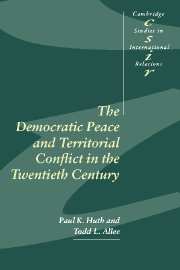Book contents
- Frontmatter
- Contents
- List of figures
- List of tables
- Acknowledgments
- 1 Another study of democracy and international conflict?
- 2 Pathways to conflict escalation and resolution in international disputes
- 3 The international strategic context
- 4 Domestic institutions and the Political Accountability Model
- 5 Domestic institutions and the Political Norms Model
- 6 Domestic institutions and the Political Affinity Model
- 7 Empirical results for decisions to challenge the status quo
- 8 Empirical results for decisions to offer concessions in negotiations
- 9 Empirical results for decisions to escalate with military force
- 10 What have we learned about the democratic peace?
- Appendices A–F
- Bibliography
- Index
- CAMBRIDGE STUDIES IN INTERNATIONAL RELATIONS
2 - Pathways to conflict escalation and resolution in international disputes
Published online by Cambridge University Press: 22 September 2009
- Frontmatter
- Contents
- List of figures
- List of tables
- Acknowledgments
- 1 Another study of democracy and international conflict?
- 2 Pathways to conflict escalation and resolution in international disputes
- 3 The international strategic context
- 4 Domestic institutions and the Political Accountability Model
- 5 Domestic institutions and the Political Norms Model
- 6 Domestic institutions and the Political Affinity Model
- 7 Empirical results for decisions to challenge the status quo
- 8 Empirical results for decisions to offer concessions in negotiations
- 9 Empirical results for decisions to escalate with military force
- 10 What have we learned about the democratic peace?
- Appendices A–F
- Bibliography
- Index
- CAMBRIDGE STUDIES IN INTERNATIONAL RELATIONS
Summary
Alternative paths to conflict and cooperation
The leaders of both democratic and authoritarian states engage in varied patterns of diplomatic and military behavior. In some international disputes we find examples of the aggressive use of military force and intransigent bargaining strategies, while in other disputes military inaction and accommodative diplomacy are equally evident. When and why do democratic and authoritarian leaders at times pursue conflictual policies? Conversely, why do they at other times seek the resolution of international disputes through compromise and concessions? Do differences in the domestic political institutions of states influence the foreign policy choices of political leaders in a consistent and systematic fashion, such that domestic politics models can explain patterns of international conflict escalation and resolution? These are the critical questions that motivate our efforts at theory building in this book.
The starting point for developing theory is to think broadly about the causal pathways that are associated with (a) the presence or absence of military conflict between states, and (b) the continued stalemate or settlement of international disputes. Figure 2.1 presents four different stages that are associated with the development of international disputes over time, along with some of the principal pathways leading to different diplomatic and military outcomes. The Dispute Initiation Stage centers on the emergence of a dispute or disagreement between countries in which a challenger state seeks to alter the prevailing status quo over some issue(s). If a target state rejects the challenger's claims, then a dispute exists.
- Type
- Chapter
- Information
- Publisher: Cambridge University PressPrint publication year: 2003

